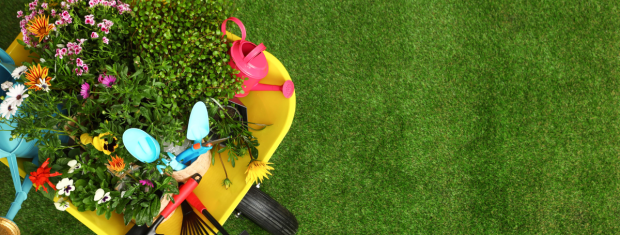
Spring Cleanup: 5 Yard Work To-Do’s
Spring cleaning isn’t just something to address inside of your home, it’s something to address on the outside of your home as well! Giving your lawn and landscaping some TLC at this time of year will help prepare your yard for the rest of the growing season:
1. General Refuse Cleanup
The most important thing you can do following winter is clearing your lawn of any debris. This will help promote adequate airflow and prevent any possible dead spots from mold/decay. Remove items like:
- Dead grass, leaves, pinecones, etc.
- Litter and dog feces
- Any broken glass/plastic (use care with broken glass, making sure to wear heavy work gloves)
Remember to be gentle with your lawn when removing these items, especially if the ground is moist. It is best to wait for a dry day where the temperature will be in the high 40’s or the 50’s.
2. Prune Away Dead & Damaged Branches
Locate any tree or shrub branches that have been damaged by cold, snow or wind and prune them back to live stems. Shaping hedges with pruners will allow sunlight and air to reach the shrubs center and promote healthy growth. Dead branches located near your roof line or a power line should be trimmed immediately to prevent any possible damage.
Pay attention to what you are pruning; most shrubs and trees should be pruned in late winter or early spring but not all. Flowering shrubs, for example, need some extra care:
- Summer-flowering shrubs should be pruned hard at the end of winter or very early spring BEFORE any new growth starts.
- Spring-flowering shrubs should be pruned after spring flowers fade. Due to the fact that these bloom based on the growth of the previous season, you don’t want to cut off any healthy buds or flowers by pruning too early.
3. Tend to Fences & Trellises
Remove any pickets or lattice that are badly rotted or damaged, installing new wood as needed. You can patch minor rotted sections with a wood epoxy. Examine unstable fence posts and determine if they need to be replaced. Sometimes one small section can wreak havoc on your entire fence line.
You can give your fence a nice pick-me-up by sanding it down and applying a new finish coat. Wait until temperatures rise above 50° F to apply a new coat of paint or stain.
4. Address Aggressive Weeds
It’s best to get a hold on weeds in early spring before they start to take over your lawn. Invasive and aggressive weeds get worse throughout the summer thanks to long daylight hours and warm temperatures. As they grow, their roots will strengthen and they will be very difficult to remove.
Here are some best practices to consider to minimize weeds in your lawn:
- Do not mow your lawn too short
- Allow some mow clippings to return to the lawn
- Skip spring fertilization
- Don’t over- or underwater
For extra protection, you may opt to apply a “pre-emergent” herbicide. The best time to apply a pre-emergent is when the temperature in the top 1 inch of soil has been 55° F for five consecutive days (often in March and April). Once the soil temperatures rise to 55° F, annual weed seeds begin to germinate. Once you can see weeds in your lawn, a pre-emergent herbicide is not effective.
A post-emergent herbicide can also be used in late spring after weeds have already flowered. Weed killers are most effective when applied evenly over the entire lawn.
5. Replenish & Re-seed
Whether you have small dead patches or large weak areas in your lawn due to heavy traffic, you may wish to re-seed some spots to elicit a healthier, fuller lawn.
While fall tends to be the best time to re-seed, it can also be done early spring before you apply any pre-emergent. Before seeding, use a steel rake to scuff up the area and loosen the soil. Add some compost to help speed up germination. Sprinkle the grass seed onto the spot and be sure to keep it moist for the next several days. Cover the seeds with some sort of straw matting or other material to protect the seeds and secure them in place. Allow the new grass seeds enough time to germinate and establish.
Everyone enjoys a nice luscious lawn in the summertime. Using some of the above simple tips will help you get closer to your dream lawn!


